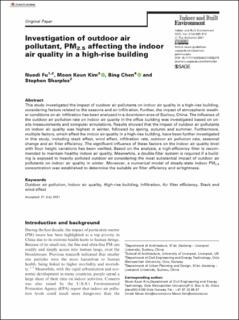| dc.contributor.author | Fu, Nuodi | |
| dc.contributor.author | Kim, Moon Keun | |
| dc.contributor.author | Chen, Bing | |
| dc.contributor.author | Sharples, Stephen | |
| dc.date.accessioned | 2022-10-17T07:26:48Z | |
| dc.date.available | 2022-10-17T07:26:48Z | |
| dc.date.created | 2021-11-15T14:57:44Z | |
| dc.date.issued | 2021-11-12 | |
| dc.identifier.citation | Indoor and Built Environment. 2021, 1-18. | en_US |
| dc.identifier.issn | 1420-326X | |
| dc.identifier.issn | 1423-0070 | |
| dc.identifier.uri | https://hdl.handle.net/11250/3026276 | |
| dc.description.abstract | This study investigated the impact of outdoor air pollutants on indoor air quality in a high-rise building, considering factors related to the seasons and air infiltration. Further, the impact of atmospheric weather conditions on air infiltration has been analysed in a downtown area of Suzhou, China. The influence of the outdoor air pollution rate on indoor air quality in the office building was investigated based on onsite measurements and computer simulations. Results showed that the impact of outdoor air pollutants on indoor air quality was highest in winter, followed by spring, autumn and summer. Furthermore, multiple factors, which affect the indoor air quality in a high-rise building, have been further investigated in this study, including stack effect, wind effect, infiltration rate, outdoor air pollution rate, seasonal change and air filter efficiency. The significant influence of these factors on the indoor air quality level with floor height variations has been verified. Based on the analysis, a high-efficiency filter is recommended to maintain healthy indoor air quality. Meanwhile, a double-filter system is required if a building is exposed to heavily polluted outdoor air considering the most substantial impact of outdoor air pollutants on indoor air quality in winter. Moreover, a numerical model of steady-state indoor PM2.5 concentration was established to determine the suitable air filter efficiency and airtightness. | en_US |
| dc.description.sponsorship | This work was supported by the Research Development Fund (RDF 15–02-32) of Xi’an Jiaotong – Liverpool University, Zhejiang Provincial Natural Science Foundation (LY19E080001), the UK ICE Research Development Enabling Fund (ICE_RDF_2020), and the Department of Civil Engineering and Energy Technology of Oslo Metropolitan University. | en_US |
| dc.language.iso | eng | en_US |
| dc.publisher | SAGE Publications | en_US |
| dc.relation.ispartofseries | Indoor and Built Environment;Volume 31, Issue 4 | |
| dc.rights | Navngivelse-Ikkekommersiell 4.0 Internasjonal | * |
| dc.rights.uri | http://creativecommons.org/licenses/by-nc/4.0/deed.no | * |
| dc.subject | Outdoor air pollution | en_US |
| dc.subject | Indoor air quality | en_US |
| dc.subject | High-rise buildings | en_US |
| dc.subject | Infiltration | en_US |
| dc.subject | Air filter efficiency | en_US |
| dc.subject | Stack and wind effects | en_US |
| dc.title | Investigation of outdoor air pollutant, PM2.5 affecting the indoor air quality in a high-rise building | en_US |
| dc.type | Peer reviewed | en_US |
| dc.type | Journal article | en_US |
| dc.description.version | publishedVersion | en_US |
| dc.rights.holder | © The Author(s) 2021 | en_US |
| cristin.ispublished | true | |
| cristin.fulltext | original | |
| cristin.qualitycode | 1 | |
| dc.identifier.doi | https://doi.org/10.1177/1420326X211038279 | |
| dc.identifier.cristin | 1954764 | |
| dc.source.journal | Indoor and Built Environment | en_US |
| dc.source.volume | 31 | en_US |
| dc.source.issue | 4 | en_US |
| dc.source.pagenumber | 895–912 | en_US |
| dc.relation.project | Xi’an Jiaotong – Liverpool University: RDF 15–02-32 | en_US |
| dc.relation.project | Zhejiang Provincial Natural Science Foundation: LY19E08000 | en_US |
| dc.relation.project | UK ICE Research Development Enabling Fund: ICE_RDF_2020 | en_US |

